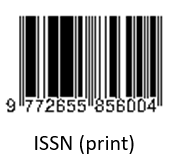Evaluation of Impact of Biofertilizer and Mulch Types on Growth and Production of Tomato Cultivar Gustavi F1 in Lowland Areas
(1) Lampung State Polytechnic
(2) Lampung State Polytechnic
(3) Lampung State Polytechnic
(4)
(5)
(6)
(7)
(*) Corresponding Author
Abstract
Tomato plants are expected to have an ideal growing environment to optimize their growth and production. Therefore, this study aimed to investigate the effect of various concentrations of biofertilizer, mulch types, and their interactions on growth and production of the Gustavi F1 tomato cultivar. A randomized group design (RGD) arranged factorially was used for the analysis, with the first factor consisting of no mulch (M0), straw mulch (M1), and plastic mulch (M2). The second factor was five biofertilizer concentrations, including 0 ml.l-1 (L0), 5 ml.l-1 (L1), 10 ml.l-1 (L2) 15 ml.l-1 (L3), and 20 ml.l-1 (L4). Data were analyzed using the F test (analysis of variance), and in cases of significant differences, the analysis proceeded with Duncan Multiple Range Test (DMRT) at an α level of 5%. Growth parameters observed in the experiments included plant height at 1 and 3 weeks after planting, while production parameters comprised fruit diameter, the number of fruits per plant, the percentage of fruits experiencing Blossom End-Rot (BER), and fruit weight per plot. The results showed that the use of plastic mulch significantly increased the number of fruits per plant, while the 0 ml.l-1 biofertilizer concentration showed the most effective reduction in the percentage of fruits experiencing BER. Moreover, an interaction between mulch and biofertilizer treatments was observed, particularly in relation to plant height 1 week after planting, the number of fruits per plant, and the percentage of fruits experiencing BER.
Keywords— generative, microbes, ground cover, vegetative
Full Text:
PDFReferences
Badan Pusat Statistik, Produksi Tanaman Sayuran 2023, Available: https://www.bps.go.id/indicator/55/61/1/produksi-tanaman-sayuran.html, 2023.
S. Sabahannur and L. Herawati, Pertumbuhan dan produksi tanaman tomat (Lycopersicum esculentum Mill.) pada berbagai jarak tanam dan pemangkasan, Jurnal Agrotek, vol. 1, no. 2, pp. 32-42, 2017.
R. Kumar, N. Kumawat, and Y.K. Sahu, Role of biofertilizers in agriculture, Popular Kheti. vol. 5, no. 4, pp. 63-66, 2017.
P. Sanjaya, N. Kurnia, K. Hendarto, and F. Yelli, Pengaruh pupuk kandang dan pupuk hayati pada pertumbuhan dan produksi tanaman tomat (Lycopersicum esculentum Mill.), Jurnal Agrotek Tropika, vol. 9, no. 1, pp. 171-176, 2021.
D.R.R. Damaiyanti, N. Aini, and Koesriharti, Kajian penggunaan macam mulsa organik pada pertumbuhan dan hasil tanaman cabai besar (Capsicum annuum L.), Jurnal Produksi Tanaman, vol. 1, no. 2, pp. 25-32, 2013.
D. Anggorowati, R. Sulistyono, and N. Herlina. Respon tanaman tomat (Lycopersicum esculentum Mill.) pada berbagai tingkat ketebalan mulsa jerami padi. Jurnal Produksi Tanaman, vol. 4, pp. 378-384, 2016.
G.D. Trenaldi, Y. Sepriani, D.H. Adam, and I.A.P. Septyani, Respon penggunaan plastik hitam perak terhadap pertumbuhan tanaman cabai merah (Capsicum annuum L.) di Perkebunan Afdeling 2 Kecamatan Bilah Barat Kabupaten Labuhan Batu, Jurnal Education and Development, vol. 10, no. 3, pp. 14-18, 2022
H. Yulianingrum, E. Supraptomo, and P. Setyanto, Pengaruh pemberian mulsa jerami padi terhadap kelimpahan gulma dan pertumbuhan tanaman tomat (Solanum lycopersicum) di lahan tadah hujan. Prosiding Konser Karya Ilmiah. Universitas Kristen Satya Wacana, Salatiga. 4 Agustus 2016, 2016.
S. Ardhona, K. Hendarto, A. Karyanto, and Y.C. Ginting, Pengaruh pemberian dua jenis mulsa dan tanpa mulsa terhadap karakteristik pertumbuhan dan produksi tanaman cabai merah (capsicum annum L.) pada dataran rendah, Jurnal Agrotek Tropika, vol.1, no. 2, pp. 153-158, 2013.
R. Rukmana, Budidaya Kubis Bunga dan Broccoli, Kanisius, Yogyakarta, 1995.
A.R. Ziladi, K. Hendarto, Y.C. Ginting, and A. Karyanto, Pengaruh jenis pupuk organik dan aplikasi pupuk hayati terhadap pertumbuhan dan produksi tanaman tomat (Solanum lycopersicum Mill.) di Desa Sukabanjar Kecamatan Gedong Tataan, Jurnal Agrotek Tropika, vol. 9, no. 1, pp. 145-151, 2021.
R.D.M. Simanungkalit, A.S. Didi, S. Rasti, S. Diah, and H. Wiwik, Pupuk Organik dan Pupuk Hayati, Balai Besar Penelitian dan Pengembangan Sumberdaya Lahan Pertanian, Jawa Barat, 2006.
R. Fadel, R. Yusuf, and A. Syakur, Pertumbuhan dan hasil tanaman tomat (Lycopersicum esculentum mill.) pada pemberian berbagai jenis mulsa, Jurnal Agrotekbis, vol. 5, no. 2, pp. 152 – 160, 2017.
C. Rachmah, M. Nawawi, and Koesriharti, Pengaruh aplikasi pupuk kalsium (CaCO3) dan giberaline pada pertumbuhan, hasil, dan kualitas buah pada tanaman tomat (Lycopersicum esculentum Mill.), Jurnal Produksi Tanaman, vol. 5,no. 3, pp. 515-520, 2017.
L.C.Ho and P. Adams, Nutrient uptake and distribution in relation to crop quality, Acta Hort, 396: 33-44, 1995.
DOI: https://doi.org/10.24071/ijasst.v6i1.7536
Refbacks
- There are currently no refbacks.
Publisher : Faculty of Science and Technology
Society/Institution : Sanata Dharma University

This work is licensed under a Creative Commons Attribution 4.0 International License.











